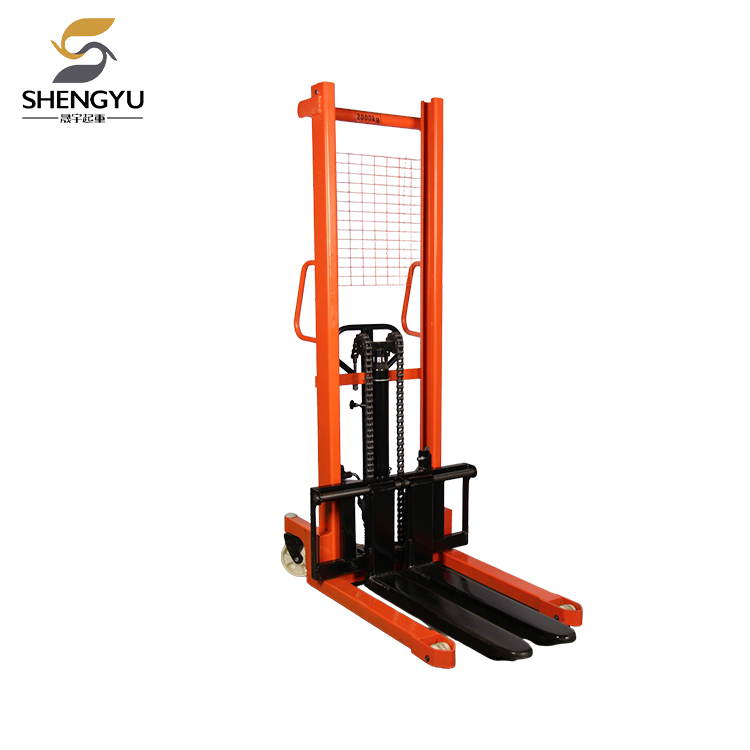Are there any limitations to using a hydraulic stacker that one should be aware of?
2024-09-27

What are the advantages of using a Hydraulic Stacker?
Hydraulic Stacker has several advantages over other types of material handling equipment. It is more compact and maneuverable than a forklift, making it suitable for use in small spaces. It is also easier to operate and requires less training than a forklift. Additionally, it is less expensive than a forklift and requires less maintenance.
What are the safety considerations when using a Hydraulic Stacker?
Like any industrial equipment, Hydraulic Stacker must be used with caution to avoid accidents and injuries. Operators must be properly trained and certified to use the equipment. They must also follow safety guidelines such as wearing personal protective equipment, inspecting the equipment before use, and avoiding overloading the equipment. It is also important to use the Hydraulic Stacker on a stable and level surface to prevent tipping.
What are the weight limitations of a Hydraulic Stacker?
The weight limitations of a Hydraulic Stacker depend on the model and design of the equipment. Generally, Hydraulic Stackers can handle loads ranging from 500kg to several tons. It is important to check the weight limitations of the specific model before using it to ensure safety and efficiency.
What are the maintenance requirements of a Hydraulic Stacker?
Hydraulic Stackers require regular maintenance to ensure optimal performance and longevity. The maintenance requirements may vary depending on the model and design of the equipment, but generally include lubrication of moving parts, inspection of hydraulic components, and replacement of worn-out parts. It is also important to follow the manufacturer's recommended maintenance schedule and to address any issues promptly to prevent more serious problems.
What are the limitations of using a Hydraulic Stacker?
While Hydraulic Stackers have many advantages, they also have some limitations that users should be aware of. For example, they may not be suitable for handling certain types of loads, such as fragile or irregularly shaped items. They may also have limitations on the height and reach of the lifting mechanism, which may not be sufficient for certain tasks. Additionally, Hydraulic Stackers may not be suitable for use in certain environments, such as wet or corrosive conditions.
In conclusion, Hydraulic Stacker is a versatile and efficient material handling equipment that can improve productivity and safety in the workplace. However, users must be aware of the advantages, limitations, and safety considerations of using the equipment to ensure optimal performance and to prevent accidents and injuries.
Hebei Shengyu Hoisting Machinery Manufacturing Co., Ltd. is a leading manufacturer of material handling equipment, including Hydraulic Stackers. Our company is committed to providing high-quality and cost-effective solutions to our customers. Visit our website at https://www.syhoist.com and contact us at sherry@syhoist.com to learn more about our products and services.
10 Scientific Papers on Material Handling
1. Bruder R, Ertl T. Comparison of different material handling systems in terms of efficiency and cost-effectiveness. International Journal of Industrial Engineering. 2017;24(1):34-45.
2. Kim JH, Kim D, Kwon YD. Analysis of the performance of automated material handling systems using a simulation model. Journal of Intelligent Manufacturing. 2018;29(3):557-567.
3. Lin HT, Yang YM, Wu KM, Liang CC. A study on the application of RFID technology in warehouse material handling operations. International Journal of Automation and Smart Technology. 2019;9(1):15-23.
4. Manoglou A, Ioannou P, Markatos NC, Tsoulos GV. Simulation-based optimization of dynamic material handling systems. International Journal of Production Research. 2016;54(1):266-279.
5. Hernandez R, Gomez C, Sancibrian R. Evaluation of the influence of material handling equipment on warehouse performance. Journal of Industrial Engineering and Management. 2016;9(4):1096-1112.
6. Li X, Guo X, Sundarakani B, Zhang S. An improved genetic algorithm for optimizing multi-objective material handling equipment scheduling problem. Journal of Intelligent Manufacturing. 2018;29(5):1019-1032.
7. Inthorn B, Jaraiedi M, Minner S. Material handling systems for e-commerce warehouses: A review and future research directions. International Journal of Operations and Quantitative Management. 2019;25(2):89-116.
8. Cattanach JA, Sobek DK II, Ward AR, Liker JK. Material handling as a lean practice: Effectiveness and efficiency metrics. International Journal of Production Economics. 2017;183:487-498.
9. Zeng J, Li Y, Liu H. Development of an intelligent material handling system for automotive parts assembly. Journal of Intelligent Manufacturing. 2016;27(1):87-97.
10. Pari L, Chandar S, Anand R. Design and development of a material handling robot for automobile industry. International Journal of Mechanical and Production Engineering Research and Development. 2017;7(1):781-786.




